 Farming was the main
activity of Egyptians, most of whom were peasants. Egypt would not have
existed without the Nile and its annual flood, which brought water and rich
mud, valuable for the growing of crops. The two main crops were wheat (3
kinds - emmer, einkorn and spelt), and barley, which were used to bake bread
and make beer. Egyptian farmers worked not for themselves but for the
pharaoh, a temple, or a nobleman. Their pay was a proportion of the grain
they produced.
Farming was the main
activity of Egyptians, most of whom were peasants. Egypt would not have
existed without the Nile and its annual flood, which brought water and rich
mud, valuable for the growing of crops. The two main crops were wheat (3
kinds - emmer, einkorn and spelt), and barley, which were used to bake bread
and make beer. Egyptian farmers worked not for themselves but for the
pharaoh, a temple, or a nobleman. Their pay was a proportion of the grain
they produced.

my copy of scenes from the tomb of Sennedjem - reaping and sowing, with fruit trees below
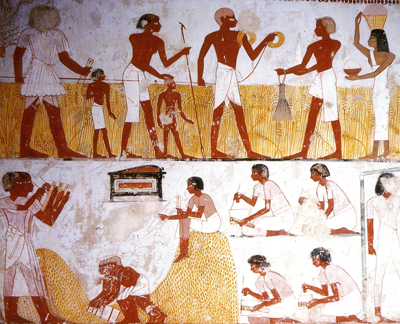
The peasants were watched carefully by overseers, and taxmen would evaluate how much grain they expected an area of farmland to produce. If the peasants failed to harvest enough grain, they would be punished. The picture shows scribes measuring the field with rope and recording the amount of grain produced.
After sowing the seed and harvesting it with
sickles (see below), the grain was threshed - sometimes by having animals
like oxen walk over it - to remove the wheat from its husk. Then it would be
winnowed (see below left). This means the grain was thrown up into the air
so the breeze could separate the wheat from the chaff. Finally the peasants
would receive their pay and take it how for their wives to grind into flour
to make bread and beer.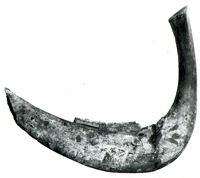
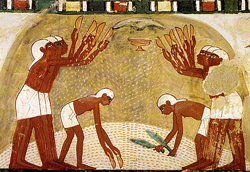
The rich soil gave two crops a year, but if a second was desired, during the summer, the crops had to be watered by hand, using a shaduf - a special bucket which was dipped into a canal. In fact the three seasons of the year were based on the cycle of farming: akhet was the season of the flood over the hot summer months, peret was the growing season, and shemu was the spring harvest. My story takes place in shemu, around April.
Other important crops were: flax - from which linen was made; grapes for making wine; and dates from date palms. At home peasants would grow vegetables in their own plots - peas, beans, lettuce, garlic, onions, cabbage, and cucumbers.
Of course the Egyptians also kept animals - cows, sheep, goats, ducks and geese, and pigs - although pigs, which were considered dirty and unholy, were hardly ever shown in paintings.
Houses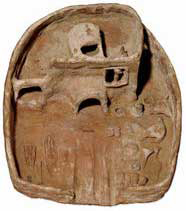
Poor Egyptians (like Ahmose and his family) lived in very small houses. They were usually made of mud brick - that is, mud with straw added, put into frames so they could dry in the sun into a brick shape. The roofs were usually made of reeds or palm leaves. The houses had only two or three rooms and usually had a small garden at the front, enclosed by a wall. Vegetables might be grown in this garden, or animals kept there such as geese and goats. Often the family would have pets like dogs and cats (good for keeping away vermin). There would be very little furniture - stools, boxes to keep clothes etc. in, an oven, perhaps a bed or just straw to sleep on. The picture shows a clay model of an Egyptian house.
The houses of the rich were quite different - much larger and luxurious, with big gardens. The pictures below show a plan of a nobleman's villa and a garden (like Nebamun's). See how enormous they are! In the garden you can see rectangular pools which the Egyptians loved, plus grapevines in the middle, and lots of trees including date palms.
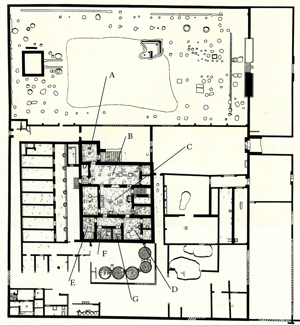
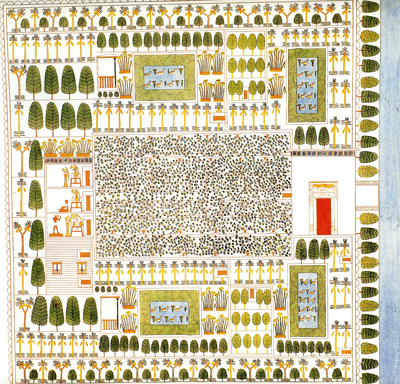
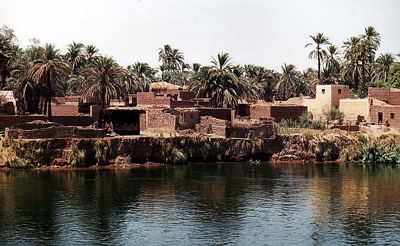
Villages
Because of the Nile flood, villages were usually built on high ground - little hills. Mud bricks did not last long, and certainly would not survive a flood. Here is a photo of a modern Egyptian village by the Nile, with houses made of mud brick much as they were thousands of years ago.
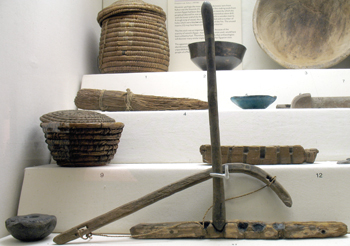 Firesticks
Firesticks
Egyptians would usually use a firestick to start a fire. The picture shows a firestick (or fire drill) from the Manchester museum.
The tall stick is placed in another piece of wood called the matrix - here you can see the matrix with some charred holes in it. The bowstring (the bow is the j shaped object) was wrapped around the firestick. The cap you can see to the left - this was held over the top of the stick to keep it in place. Then the person would pull the bow back and forth, which made the stick spin quickly against the matrix. The heat produced by this friction caused a flame. Bits of dry grass could be lit and so a fire started!
You can also see some reed baskets in this picture, and some bowls.